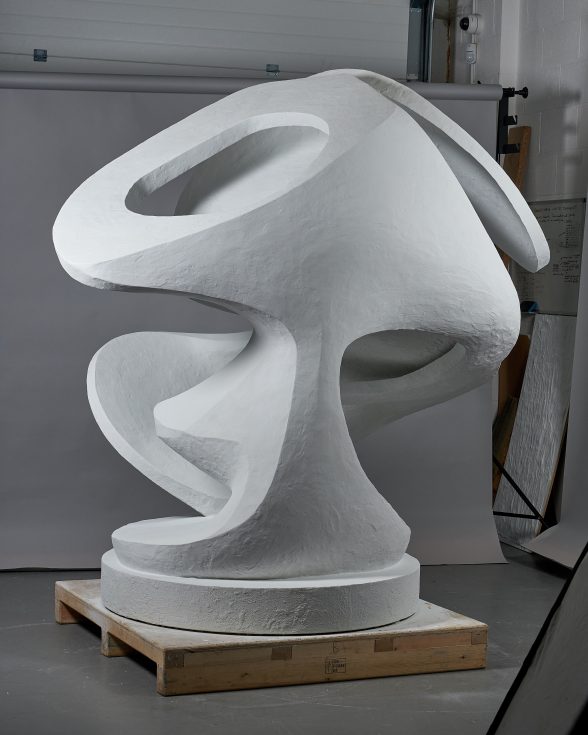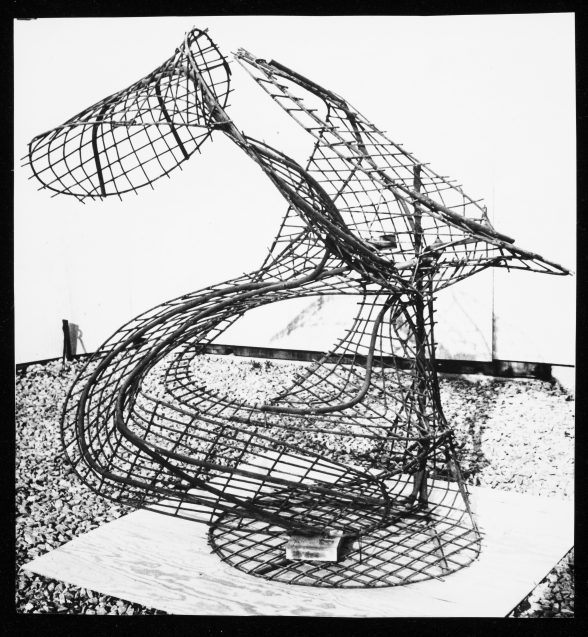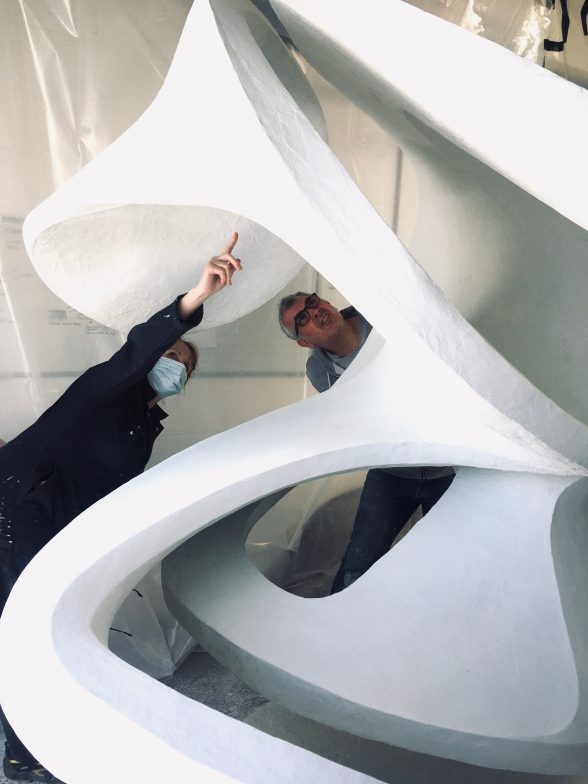This website uses cookies
This website uses cookies to enable it to function properly and to analyse how the website is used. Please click 'Close' to accept and continue using the website.



Barbara Hepworth © Bowness
Photo: Barney Hindle
An unusual concrete sculpture by Barbara Hepworth has been painstakingly restored and will feature in a forthcoming exhibition at the Hepworth Gallery, Wakefield.
Turning Forms was the first work that Barbara Hepworth made in concrete. It sat on a slowly rotating plinth, outside The Thameside restaurant, at the main South Bank Festival of Britain site, completing one stately revolution every two minutes. The restaurant was designed by Jane Drew (as partner in the firm Maxwell Fry & Jane Drew), who was an admirer of Hepworth’s work. Drew had a major role at the 1951 Festival, and was also responsible for the Harbour Bar and the Health and New Schools pavilions. She used her influence to secure direct Festival funding for a work she felt would complement her building especially well. Whilst most of the other sculptures, both at the South Bank and in Battersea Park, were commissioned by the Arts Council (including Hepworth’s better-known Contrapuntal Forms, in Irish blue limestone, which is now on the Glebelands housing estate in Harlow.) The Festival board paid for Turing Forms directly.

Barbara Hepworth © Bowness
Photo: Barney Hindle
The list description for the work emphasises how dissimilar it is to much of the artist’s work, describing it as “an unusual kinetic composition, a helix structure originally made to turn by an electric motor. The constructivist composition has a strong affinity with the work of Naum Gabo, rare in Hepworth’s large-scale work.”
When the Festival closed, Turning Forms was given to Hertfordshire County Education Authority and sited in front of St Julian’s School, St Albans, in 1952 (now the Marlborough Science Academy). In October 2020, after nearly seventy years outside, it was moved to the Jackson Sculpture Conservation studio for major conservation work. Hertfordshire County Education Authority were pivotal in enabling the restoration.

©️ Bowness
Careful scientific analysis, research and information from the Hepworth estate showed that its original steel frame was made by F J Moore LTD of Plymouth, and coated with Vermiculite to form a comparatively lightweight rough core, which was transported to Hepworth’s Trewyn Studio. There the concrete was built up and carved back. The final surface finish was of Snowcrete with an applied wash of Snowcem. The conservators discovered that this was not a wash but a proper coherent applied layer. However, over the last ten years on site it had been refreshed with several layers of white Sandtext exterior paint.
Both Snowcrete and Snowcem were proprietary cement-based products developed by Blue Circle and a history of the firm provided more information:
Snowcrete was developed by the group in the 1920s. Here was something decorative, something to give boring old cement a bit of glamour. Initially manufactured at Magheramorne in Northern Ireland, it was subsequently made in West Kent on the Medway. Snowcrete brought the possibility of coloured cements and development was carried further to produce Colorcrete. During the Second World War further development was carried out following the Government’s request to produce a camouflage paint. This development led to the introduction of Snowcem, which was Snowcrete with some additives and was effectively a paint. For a time, it was enormously successful as other paints were largely unavailable. It was produced in plants in India, Thailand, Brazil and Singapore, and reached a peak output from Blue Circle plants of 10,000 tons a year in the early 1960s. For many years it was highly profitable for the Group but its growth declined with the advent of emulsion and resin-based paints.

Photo: India Carpenter
Once the work was in the conservation studio, Tessa Jackson could assess the extent of cracks, mould growth, land losses to the surfaces, and pull a team together to enable her to restore it, of which I was excited to be part (drawing on my expertise/experience of historic concrete conservation). It was gently cleaned by Andy Coxall (cement specialist) using a ThermaTec steam cleaning system, a process originally developed for cleaning delicate architectural stonework. Andy Coxall also carried out concrete analysis and worked on the removal and replacement of large structural fills and advised on the concrete throughout.
After sufficient time for drying out Tessa was able to replace some areas of loss, and consider how best to reinstate the surface, to replicate the original effect as accurately as possible.
Amazingly Snowcem is still manufactured to the original formula, and Snowcem specialists David and Robert Buck from Northern Paints and Coatings came to the studio and applied the final layers to the work. Taking great care not to obscure the fine surface detail, they spray applied the product in two very fine layers which were later gently smoothed back to recreate the hand finish.

It’s now ready to head to Wakefield, where it will be shown alongside Hepworth works on other media. A particular objective of the exhibition is to draw on new research from the recently established Hepworth Research Network (HRN), in collaboration with the Universities of York and Huddersfield, into the ways material factors shaped Hepworth’s sculptures and how they related to her broader conceptual and aesthetic concerns. This will include how starting bronze casting in the 1950s enabled Hepworth to create new forms and how, later in life, she experimented with new materials such as lead crystal and aluminium. Also on display will be The Hepworth Wakefield’s unique collection of 44 surviving prototypes in plaster, aluminium and wood, many of which show the marks of Hepworth’s own hand and tools. These will be shown with a specially commissioned intervention by artist Veronica Ryan, the first artist to undertake a residency in Hepworth’s old studio in St Ives, where the prototypes once stood.
Sadly, it has not been possible to physically make Turning Forms rotate again, but there is a short film of it moving one rotation in 2 minutes made by Huddersfield University. There is also a documentary film being made by Royal society of sculptors. After the exhibition closes it will return once more to the Marlborough Science Academy. Its condition will be monitored, and any repairs needed carried out in a timely fashion.

Become a C20 member today and help save our modern design heritage.
Comments